blog


This blog post is the fourth in a series about improving clinical judgment in newly hired nurses.
Teaching a clinical judgment competency for nursing students and new nurses is far more effective if you use an overall process that is systematic and formalized. Just such a method was shared during a recent HealthStream webinar, Improving Clinical Judgment in New Nurse Hires to Improve Patient Outcomes. The presenters for this webinar were Dr. Linda Caputi, a nursing education consultant, and Elease Caracci, Senior Product Manager at HealthStream. Caputi has over 30 years of teaching experience at all levels of nursing education. She is a certified nurse educator and a fellow in the NLN's Academy of Nursing Education. Having published numerous books, articles, and book chapters, Caputi’s latest work is Think like a Nurse: A Handbook, published in 2018. Elease Caracci joined HealthStream in 2016 with our acquisition of NurseCompetency and is now a senior product manager. Caracci's background in healthcare staffing, educational planning, and curriculum development, along with her management expertise, have made her a multi-faceted performer within the healthcare industry.
Three Assumptions about Teaching Clinical Judgment Competencies
Caputi has some guidance and advice for anyone considering teaching clinical judgment competencies:
Five Steps for Teaching a Clinical Judgment Competency for Nursing
Caputi offers these steps as a way to teach individual clinical judgment competencies:
HealthStream’s learning management system and healthcare training solutions support medical training initiatives and allow for the best patient care.
View All Learning & PerformanceExpand the decision-making skills and effectiveness of your healthcare workforce with HealthStream's workforce development programs and services.
View All Clinical DevelopmentComprehensive, industry-leading provider onboarding and credentialing software that validates health outcomes and supports provider assessment.
View All CredentialingMake sure your healthcare staff can schedule out appointments and work schedules with ease using our line of nurse scheduling software solutions.
View All SchedulingWhen you enact HealthStream's quality compliance solutions, you can do so with the confidence your healthcare organization will meet all standards of care.
View All Quality & ComplianceTransform end-to-end revenue cycle management with comprehensive education
View All Revenue Cycle EducationLearn about our advanced resuscitation training solutions. Our solutions are designed to help improve patient outcomes.
View All Resuscitation